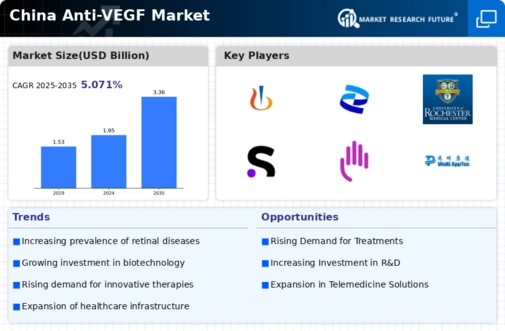The China Anti-VEGF Market is characterized by a competitive landscape driven by the increasing prevalence of retinal diseases, the necessity for advanced therapeutic solutions, and a growing pool of patients requiring treatment. With a significant uptick in investments directed towards biotechnology and pharmaceuticals, the market is witnessing an evolution in treatment modalities aimed at combating conditions such as age-related macular degeneration and diabetic retinopathy. Numerous players are vying for market share, focusing on both innovation and meeting the regulatory requirements laid out by the Chinese healthcare authorities.
The dynamic environment is primarily propelled by the need for efficient and effective drug therapies, alongside collaborations, partnerships, and mergers that seek to enhance product offerings and distribution networks.
Sihuan Pharmaceutical Holdings Group has established a notable presence in the China Anti-VEGF Market through its strategic focus on developing innovative medicines tailored to ocular conditions. Its strength lies in robust research and development capabilities that enable the company to push boundaries and deliver effective treatments in a timely manner. Sihuan’s commitment to high-quality manufacturing processes and adherence to regulatory standards bolsters its reputation within the industry while also ensuring that it meets the diverse needs of Chinese patients.
With an expansive distribution network across the country, the company has solidified its footprint, enhancing accessibility for patients in need of anti-VEGF therapies and establishing itself as a credible entity in the ophthalmic pharmaceutical sector.
Regeneron Pharmaceuticals has made significant advancements in the China Anti-VEGF Market, particularly with its flagship product aimed at treating various retinal diseases. The company’s market presence is reinforced by its well-established reputation for research and innovation in the biological therapeutics space. Regeneron has strategically aligned itself with local stakeholders and authorities, enhancing its ability to penetrate the market effectively. Their strengths include unique product offerings that cater specifically to the demands of patients suffering from retinal conditions, bolstered by ongoing clinical trials aimed at expanding treatment indications.
The company’s commitment to maintaining a competitive edge is evident through ongoing collaborations and potential mergers aimed at fostering growth and improving patient outcomes throughout China, thereby asserting its role as a leading player in the anti-VEGF therapy domain.
















